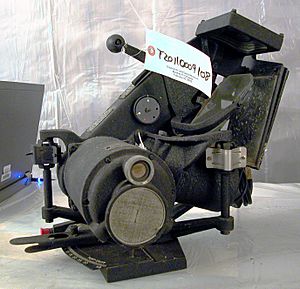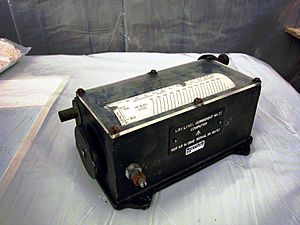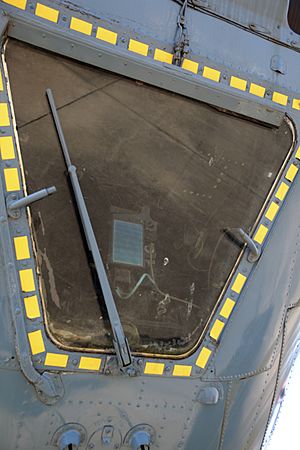Low Level Bombsight, Mark III facts for kids
The Low Level Bombsight, Mark III was a special aiming device used by the Royal Air Force (RAF) during World War II. It helped planes drop bombs very accurately when flying low, usually below 1,000 feet (about 300 meters). This bombsight was also known as the Angular Velocity Sight. It combined parts from an older bombsight, the Mark XIV, with a new mechanical computer.
The Mark III was mostly used by Coastal Command aircraft. These planes hunted German submarines, called U-boats. Using this bombsight, the chance of destroying a U-boat went up by 35%, and damaging it by 60%! It was also used a bit by Bomber Command on De Havilland Mosquito planes for special low-level attacks. One time, it was even used on an Avro Lancaster bomber. After the war, it stayed in use on the Avro Shackleton aircraft until 1991.
Contents
History of the Bombsight
In 1941, experts studying how Coastal Command planes were doing against German U-boats found something important. Planes could aim bombs well from side to side, but they had big trouble knowing the exact moment to drop them. This meant a new bombsight was needed, one made just for attacking targets from low heights.
Early versions of the Mark III bombsight were given to two RAF squadrons. In December 1942, pilots from No. 59 Squadron RAF tested the new sight. They dropped bombs on targets that were not moving, and then on targets moving at 8 knots (about 15 km/h). When attacking the moving target, their bombs landed, on average, only 18 yards (about 16 meters) away from the target. One amazing example showed an error of only 6 yards (about 5.5 meters) when dropping from 800 feet (about 240 meters)! Pilots and navigators said the sight was a huge improvement.
Because of these good reports, Air Chief Marshal Philip Joubert decided the Mark III was needed for real operations. At first, it was mainly used for patrols over the Atlantic Ocean. Later, in 1944, there were ideas to use the Mark III with a special searchlight called a Leigh Light for night attacks.
Strike Wings and New Tactics
Before the war, many thought torpedoes were the best weapon against ships. But during the war, it became clear that bombs could be much more effective against smaller ships. Torpedoes were expensive and often broke or dove too deep in shallow water.
This led to new ways of attacking called "Strike Wings." Instead of different types of planes attacking loosely, Strike Wings used groups of fast, identical planes. They would arrive together, attack quickly, and then leave. This made attacks safer and more effective.
The Mark III bombsight was used in some of these Strike Wing attacks. Later in the war, older Handley Page Halifax bombers were given to Coastal Command. They were fitted with the Mark III and used for long-range attacks on German ships.
Bomber Command's Use
Arthur Harris, who led Bomber Command, also wanted the Mark III bombsight. He ordered it for his planes in October 1942.
Coastal Command got the bombsights first, so Bomber Command only received a small number. The first ones arrived in May 1943 and were put on Douglas Boston bombers. In 1944, the famous No. 617 Squadron RAF (the Dambusters) tested the sight on their Avro Lancasters. They even carried out one low-level attack with them. Most of the Mark III bombsights sent to Bomber Command were used on De Havilland Mosquito planes, especially by No. 627 Squadron RAF.
After the War
The Mark III bombsight continued to be used by Coastal Command after World War II. It was a key piece of equipment on the Avro Shackleton aircraft for its entire service life, right up until 1991.
How Low-Level Bombing is Different
When a plane drops a bomb, the bomb keeps moving forward because of the plane's speed, but it also falls because of gravity. This creates a curved path. Air resistance (drag) also slows the bomb down.
From very high up (like 20,000 feet or 6,000 meters), a bomb might travel forward about 7,500 feet (2,300 meters) before hitting the ground. The target looks like it's far below the plane. Bomb aimers use a special sight to see if the plane is lined up. They wait for the target to pass through crosshairs in the sight, then drop the bomb. Wind can also push the plane around at high altitudes, so bombsights need to account for that.
But low-level bombing is very different:
- Target View: When flying low (like 1,000 feet or 300 meters), the target is much closer and appears more in front of the plane. The pilot can often see the target for most of the approach.
- Wind: Winds are usually weaker closer to the ground. Also, attack planes fly faster at low levels. This means the wind has less effect on the plane's path. The pilot can often adjust for side winds just by looking. So, low-level bombsights don't need complex wind calculations. The Mark III only needed the plane's speed and height.
- Timing the Drop: This is the biggest difference. From high up, the target moves slowly and steadily in the sight. But at low levels, the target first seems to just get bigger. Then, as the plane gets very close, it starts moving downward in the sight, and its speed seems to increase very quickly. The bombs need to be dropped during this fast-moving period. If a plane flies at 350 mph (560 km/h), being off by even a tenth of a second can make the bomb miss by 50 feet (15 meters)!
The Angular Velocity Idea
Imagine you're in a car looking at telephone poles beside the road. Far away, they don't seem to move much, just get bigger. But as you get closer, they start rushing past you very quickly. The speed at which they seem to move past you (their "angular velocity") depends on how far away they are, how fast your car is going, and how far the poles are from the road.
The Low Level Bombsight Mark III used this idea. For a plane, the "pole" is the target, the "car speed" is the plane's speed, and the "distance from the road" is the plane's height.
The bombsight's computer figured out how long it would take for a bomb to hit the ground from the plane's height and speed. It then calculated how fast the target *should* appear to be moving at the exact moment the bomb needed to be dropped.
This "angular speed" was shown on a display in the sighting head as a series of lines moving downwards. When the plane was far away, the lines would move faster than the target. As the plane got closer, the target would start moving faster in the sight. The bomb aimer waited until the target's movement matched the movement of the lines. At that exact moment, they dropped the bombs.
How the Bombsight Worked
The Mark III bombsight had two main parts:
- The computor: This was the "brain" that calculated the correct moment to drop the bomb.
- The sighting head: This was where the bomb aimer looked to see the target and the moving lines.
The sighting head was placed in the bomb aimer's window at the front of the plane. The computer was a separate box usually on the left side of the plane, connected by an electrical cable.
Inside the Bombsight
The computer was simple. It had two dials: one for the plane's speed and one for its height. You turned these large wheels to set the correct values.
Inside the computer, the height dial was connected to a large metal cylinder. This cylinder had lines marked on it that showed how long it would take for bombs to fall. The speed dial moved a pointer along this cylinder. The pointer would show the correct range for the bomb. Different sets of lines on the cylinder were used for different types of bombs.
The cylinder was also connected to an electrical system. This system sent a signal to a motor in the sighting head. The motor would turn a ring with lines on it. A projector then shined these lines onto a large glass plate at the front of the sighting head.
Behind this plate was another glass plate, which was a reflector sight. This part was connected to a special device that kept the plate stable even if the plane pitched up or down. A handle on the side allowed the bomb aimer to move the sight up or down to keep the target in view.
Using the Bombsight
Using the Mark III in combat was quite easy. As the plane approached the target, the bomb aimer would set the plane's speed and height on the computer. The moving lines would then appear on the display.
At first, the target would be far away, so the bomb aimer would use the handle to point the sight upwards. They would also turn the whole sighting head left or right to keep a vertical line centered on the target. This helped the pilot steer the plane correctly.
As the plane got closer, the target would appear to move lower in the sight. The bomb aimer would adjust the sight downwards to keep the target in view. The bombs were usually dropped when the target was about 45 degrees below the plane. The bomb aimer's main job was to watch the target and the moving lines. When the target's movement matched the lines, they pressed a button on a cable to release the bombs.




